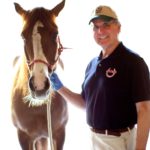by Ray Tricca, SBS Equine

In a recent study, biologists using computer modeling may have discovered the mechanism that allows some cancer cells to grow back rapidly after chemotherapy. Why this information has hoof researchers paying attention.
We all know that cancer treatments, such as radiation or chemotherapy, kill tumor cells. But sometimes, after those cells have died and been cleared away, a tumor will respond by growing faster and more aggressively. Scientists are not sure why this occurs, but recent computer modeling may have given researchers the answer. Although cancer cells are not foreign invaders as are bacteria and fungi, there are similarities in the way they spread so rapidly in open space after some treatments.
The significance of “Open Space”
As a general rule, the study reports that tissue cells do not like to be packed in too tight. When cells are crowded, reproduction can slow down or may even stop altogether. If a nearby space opens up because of a wound, say, it can prompt cells to divide and fill the gap. Tumors may be using the same mechanism to respond to the damage done by cancer treatments. “When we kill these tumor cells, we basically provide open space,” says Gunther Zupanc, professor of biology at Northeastern University in Boston “That triggers a regeneration response.”
Professor Zupanc notes that not all cancerous cells will grow into a tumor. “Computer modeling has shown that if a cancerous cell was rapidly surrounded by healthy cells, it was usually rendered inert, having no space to divide. If, on the other hand, a cancerous cell had open space to grow into, it was much more likely to evolve into a full-blown tumor. If chemotherapy or radiation kills tumor cells in an environment where there are more young healthy cells than older cells, the healthy cells can out-pace and smother the cancerous cells”.
Roll of Healthy Cells and the Immune System
The Horse-Journal completed a year-long study in 2009. They compared the most popular commercial and home remedies for treating serious thrush infections. At the end of field testing, the veterinarian researchers were surprised at the results. Only one product killed the worst cases of thrush that nothing else could touch. They also noticed that the treated areas appeared to be gentle to the surrounding healthy hoof tissue. Unconvinced, they ran the tests a second time only to get the same results. Is it possible that the best treatments stimulated the surrounding healthy cells as the catalyst in defeating the pathogens?
Another elusive hoof disease is white line disease. It is not cancer, but a mysterious chronic hoof condition involving invading bacteria and fungi. This disease has also been known to spread rapidly after treatments…especially into the open space after caustic chemicals were applied. Just as chemotherapy kills both cancer cells and healthy cells, the frequent use of caustic chemicals can kill both the pathogens and healthy cells. This creates a chronic condition that never seems to improve. After all, caustic chemicals are forms of acid that burn the pathogens. They also can be destructive to the surrounding healthy cells.
In the frequently quoted study published years ago in the AFJ – “How To Treat and Prevent White Line Disease”, by Dr. Shakalis and Dr. Pautienis of SBS Equine… they concluded, “it takes time and patience to treat these infections (white line disease) once they gain a foothold. Even if you don’t kill all the organisms initially, you may kill enough of them to slow the advancement of the disease to the point that it may grow out with successive trimmings.” SBS researchers have devoted over two decades investigating various methods of promoting healthy cell growth to control hoof disease.
The Good News
Scientists today are focusing on the immune system. They are discovering new ways to slow or stop the spread of cancer cells, pathogens, and boost the production of young healthy cells to stop them. One way immunotherapy works is to destroy cancer cells by targeting abnormal antigens expressed on the surface of tumor cells. This process kills cancer cells without harming the surrounding young healthy cells.
Combining chemotherapy with immunotherapies is proving to be an effective strategy against many forms of cancer. It is helping to reduce many of the side effects and to improve outcomes. Hoof researchers are using similar strategies to eliminate invading pathogens without the use of caustic chemicals. They have found ways to reduce the ability of pathogens to reproduce or kill enough of them without harming the surrounding healthy cells. This process stimulates young healthy cells to thrive and to choke-out pathogens in open space.
Caution When Using Home Remedies
Most home remedies and commercial preparations containing caustic ingredients work by basically burning pathogens to death. There is no doubt that caustic ingredients can kill pathogens. They also may be harmful to healthy cells trying to grow out. When used in moderation or in the early stages, these remedies may slow the advancement of the disease. There is a point where healthy cells can grow out and prosper. This is just as Drs Shakalis and Pautienis concluded in their study.
It is best to avoid the use of home remedies or dangerous caustic agents when treating abnormal hoof conditions. Unless supervised by a veterinarian, home remedies can be disastrous and irreversible, especially when used too frequently or in the wrong concentrations. For more informative articles on hoof care visit SBS Equine.




